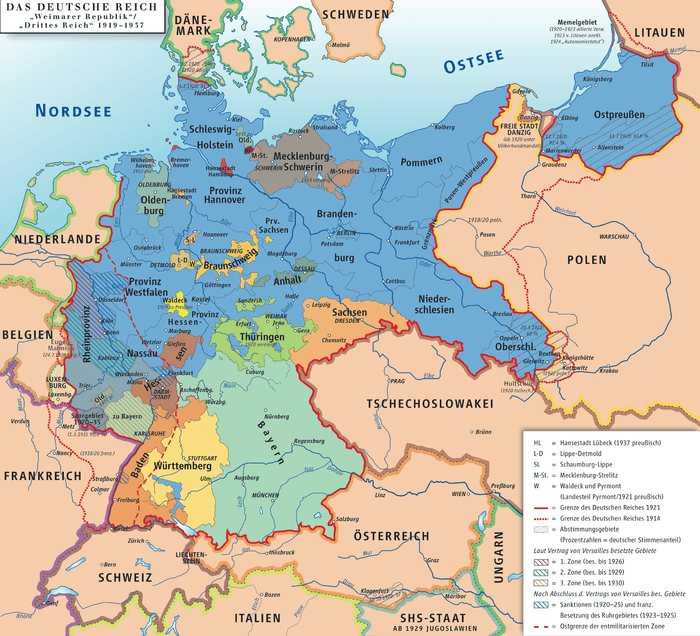Thuringia
| Free State of Thuringia Freistaat Thüringen | |||
|---|---|---|---|
| State of Germany | |||
| |||
 | |||
| Coordinates: 50°51′40″N 11°3′7″E / 50.86111°N 11.05194°E | |||
| Country | Germany | ||
| Capital | Erfurt | ||
| Government | |||
| • Minister-President | Christine Lieberknecht (CDU) | ||
| • Governing parties | CDU / SPD | ||
| • Votes in Bundesrat | 4 (of 69) | ||
| Area | |||
| • Total | 16,171 km2 (6,244 sq mi) | ||
| Population (2012-12-31)[1] | |||
| • Total | 2,170,460 | ||
| • Density | 130/km2 (350/sq mi) | ||
| Time zone | CET (UTC+1) | ||
| • Summer (DST) | CEST (UTC+2) | ||
| ISO 3166 code | DE-TH | ||
| GDP/ Nominal | €49.87 billion (2010) [citation needed] | ||
| NUTS Region | DEG | ||
| Website | thueringen.de | ||
The Free State of Thuringia (German: Freistaat Thüringen, pronounced [ˈfʁaɪʃtaːt ˈtyːʁɪŋən]; English /θəˈrɪndʒiə/) is a federal state of Germany, located in the central part of the country. It has an area of 16,171 square kilometres (6,244 sq mi) and 2.29 million inhabitants, making it the sixth smallest by area and the fifth smallest by population of Germany's sixteen states. Most of Thuringia is within the watershed of the Saale, a left tributary of the Elbe. Its capital is Erfurt.
Thuringia has been known by the nickname of "the green heart of Germany" (das grüne Herz Deutschlands) from the late 19th century,[2] due to the dense forest covering the land.
Thuringia is known in Germany for nature and winter sports. It is home to the Rennsteig, Germany's most famous hiking trail, and the winter resort of Oberhof. Germany has won more Winter Olympics gold medals than any other country in the last 20 years, and half of Germany's gold medals have been won by Thuringian athletes.[3]
Johann Sebastian Bach spent the first part of his life (1685-1717) and important further stages of his career in Thuringia. In the classical period, Goethe and Schiller lived at Weimar. Both worked also in the famous University of Jena nearby, which now hosts the most important centre of science in Thuringia. Other Universities of this federal state are the TU Ilmenau, the University of Erfurt, and the Bauhaus University of Weimar.
Etymology and symbols

The name Thuringia or Thüringen derives from the Germanic tribe Thuringii, who emerged during the Migration Period. Their origin isn't completely known, an older theory said that they were successors of the Hermunduri, but the younger research rejected that. Other historians argue that the Thuringians were allies of the Huns, came to central Europe together with them and lived prior in what is Galicia today. Publius Flavius Vegetius Renatus first mentioned the Thuringii around 400; during that period, the Thuringii were famous for their excellent horses.
The Thuringian Realm existed until 531 and later, the Landgraviate of Thuringia was the largest state in the Region, persisting between 1131 and 1247. Afterwards there was no state named Thuringia anymore, nevertheless the terminus stayed common for the region between the Harz mountains in the north, the Weiße Elster river in the east, the Franconian Forest in the south and the Werra river in the west. Since the Treaty of Leipzig, Thuringia had its own dynasty again, the Ernestine Wettins. Their various lands formed the Free State of Thuringia, founded in 1920, together with some other small principalities. The Prussian territories around Erfurt, Mühlhausen and Nordhausen joined Thuringia in 1945.
The coat of arms of Thuringia shows the lion of the Ludowingian Landgraves from 12th century origin. Furthermore, there are eight stars around it, representing the eight former states, which formed Thuringia. The flag of Thuringia is a white-red bicolor, derived from the white and red stripes of the Ludowingian lion. The coat of arms and flag of Hesse are quite smilar to the Thuringian ones, because they are also derived from the Ludowingian symbols.
Symbols of Thuringia in popular culture are the Bratwurst and the Forest, because a large amount of the territory is forested.
History
Named after the Thuringii tribe who occupied it around AD 300, Thuringia came under Frankish domination in the 6th century.
Thuringia became a landgraviate in 1130 AD. After the extinction of the reigning Ludowingian line of counts and landgraves in 1247 and the War of the Thuringian Succession (1247–1264), the western half became independent under the name of "Hesse", never to become a part of Thuringia again. Most of the remaining Thuringia came under the rule of the Wettin dynasty of the nearby Margraviate of Meissen, the nucleus of the later Electorate and Kingdom of Saxony. With the division of the house of Wettin in 1485, Thuringia went to the senior Ernestine branch of the family, which subsequently subdivided the area into a number of smaller states, according to the Saxon tradition of dividing inheritance amongst male heirs. These were the "Saxon duchies", consisting, among others, of the states of Saxe-Weimar, Saxe-Eisenach, Saxe-Jena, Saxe-Meiningen, Saxe-Altenburg, Saxe-Coburg, and Saxe-Gotha; Thuringia became merely a geographical concept.
Thuringia generally accepted the Protestant Reformation. The Catholic faith was abolished as early as 1520; priests that remained loyal were driven away and churches and monasteries were largely destroyed, especially during the German Peasants' War of 1525. In Mühlhausen and elsewhere, the Anabaptists found many adherents. Thomas Müntzer, a leader of some non-peaceful groups of this sect, was active in this city. Within the borders of Thuringia the Catholic faith was maintained only in the district called Eichsfeld, which was ruled by the Archbishop of Mainz, and to a small degree in the city and vicinity of Erfurt.
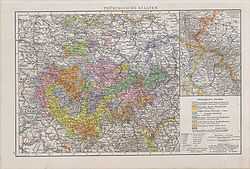
Some reordering of the Thuringian states occurred during the German Mediatisation from 1795–1814, and the territory was included within the Napoleonic Confederation of the Rhine organized in 1806. The 1815 Congress of Vienna confirmed these changes and the Thuringian states' inclusion in the German Confederation; the Kingdom of Prussia also acquired some Thuringian territory and administered it within the Province of Saxony. The Thuringian duchies which became part of the German Empire in 1871 during the Prussian-led unification of Germany were Saxe-Weimar-Eisenach, Saxe-Meiningen, Saxe-Altenburg, Saxe-Coburg-Gotha, Schwarzburg-Sondershausen, Schwarzburg-Rudolstadt and the two principalities of Reuss Elder Line and Reuss Younger Line. In 1920, after World War I, these small states merged into one state, called Thuringia; only Saxe-Coburg voted to join Bavaria instead. Weimar became the new capital of Thuringia. The coat of arms of this new state was simpler than they had been previously.
After briefly being controlled by the US, from July 1945, the state of Thuringia came under the Soviet occupation zone, and was expanded to include parts of Prussian Saxony, such as the areas around Erfurt, Mühlhausen, and Nordhausen. Erfurt became the new capital of Thuringia.
In 1952, the German Democratic Republic dissolved its states, and created districts (Bezirke) instead. The three districts that shared the territory of Thuringia were centered in Erfurt, Gera and Suhl.
The State of Thuringia was restored with slightly altered borders during Germany's reunification in 1990.
Geography
Topography
From the northwest going clockwise, Thuringia borders on the German states of Lower Saxony, Saxony-Anhalt, Saxony, Bavaria and Hesse.
The landscapes of Thuringia are quite diverse. The very north is occupied by the Harz mountains, followed by the Goldene Aue, a fertile floodplain around Nordhausen with the Helme as most important river. The north-west is taken in by the Eichsfeld, a hilly and sometimes forested region, where the Leine river emanates. The central and northern part of Thuringia is defined by the 3000 km² wide Thuringian Basin, a very fertile and flat area around Unstrut river and completely surrounded by the following hill chains (clockwise from the north-west): Dün, Hainleite, Windleite, Kyffhäuser, Hohe Schrecke, Schmücke, Finne, Ettersberg, Steigerwald, Thuringian Forest, Hörselberge and Hainich. Within the Basin the smaller hill chains Fahner Höhe and Heilinger Höhen are located. South of the Thuringian Basin, the Land's biggest mountain range is located, marked by the Thuringian Forest in the north-west, the Thuringian Highland in the middle and the Franconian Forest in the south-east. Most of this range is forested and the Großer Beerberg (983 m) is Thuringia's highest mountain. To the south-west, the Forest is followed up by the valley of Werra river, dividing it from the Rhön Mountains in the west and the Grabfeld plain in the south. Eastern Thuringia, commonly zoned as the area east of Saale and Loquitz valley, is marked by a hilly landscape, rising slowly from the flat north to the mountainous south. The Saale in the west and the Weiße Elster in the east are the two big rivers running from south to north and forming densely settled valleys in this area. Between them lies the flat and forested Holzland in the north, the flat and fertile Orlasenke in the middle and the Vogtland, a hilly but in most parts non-forested region in the south. The very eastern region (east of Weiße Elster) is the Osterland or Altenburger Land along Pleiße river, a flat, fertile and densely settled agricultural area.
The most important rivers in Thuringia are the Saale (a tributary of the Elbe) with its tributaries Unstrut, Ilm and Weiße Elster, draining the most parts of Thuringia and the Werra (the headwater of the Weser), draining the south-west and west of the Land. Furthermore, some small parts on the southern border are drained by tributaries of the Main (a tributary of the Rhine). There are no big natural lakes in Thuringia, but some of Germany's biggest dams including the Bleiloch Dam and the Hohenwarte Dam at Saale river same as the Leibis-Lichte Dam and the Goldisthal Pumped Storage Station within the Highland. Thuringia is Germany's only state without connection to navigable waterways.
The geographic center of the Federal Republic is located in Thuringia, within the municipality of Vogtei next to Mühlhausen. Thuringia's center is located only eight kilometres south of the capital's Cathedral within the municipality of Rockhausen.
Climate
Thuringia's climate is temperate with humid westerly winds predominate. Increasing from the north-west to the south-east the Land's climate shows continental features; winters can be cold for long periods, and summers can become warm. Dry periods are often recorded, especially within the Thuringian Basin, situated leeward to mountains in all directions. It is Germany's most dry area with annual precipitation of only 400 to 500 mm.
Within Thuringia are relatively big climate differences with a range from an average temperature of 8.5 °C and precipitation of 450 mm in Artern up to an average temperature of 4.4 °C [?] and precipitation of 1300 mm at Schmücke station next to Oberhof within the Thuringian Forest.
| Climate data for Erfurt (1971-2000) | |||||||||||||
|---|---|---|---|---|---|---|---|---|---|---|---|---|---|
| Month | Jan | Feb | Mar | Apr | May | Jun | Jul | Aug | Sep | Oct | Nov | Dec | Year |
| Average high °C (°F) | 2.2 (36) |
3.2 (37.8) |
7.8 (46) |
12.2 (54) |
17.5 (63.5) |
20.1 (68.2) |
22.5 (72.5) |
22.7 (72.9) |
18.3 (64.9) |
12.7 (54.9) |
6.4 (43.5) |
3.4 (38.1) |
12.4 (54.3) |
| Average low °C (°F) | −3.1 (26.4) |
−2.9 (26.8) |
0.3 (32.5) |
2.8 (37) |
7.1 (44.8) |
10.2 (50.4) |
12.1 (53.8) |
12.0 (53.6) |
9.1 (48.4) |
5.1 (41.2) |
0.9 (33.6) |
−1.5 (29.3) |
4.3 (39.7) |
| Precipitation mm (inches) | 24.7 (0.972) |
23.8 (0.937) |
35.5 (1.398) |
40.3 (1.587) |
54.8 (2.157) |
60.8 (2.394) |
62.5 (2.461) |
52.8 (2.079) |
40.5 (1.594) |
36.8 (1.449) |
37.5 (1.476) |
31.5 (1.24) |
501.5 (19.744) |
| Avg. precipitation days (≥ 1.0 mm) | 7.0 | 6.7 | 8.3 | 7.9 | 8.5 | 10.0 | 8.7 | 8.3 | 7.4 | 6.9 | 7.8 | 7.6 | 95.1 |
| Source: World Meteorological Organization[4] | |||||||||||||
Nature and environment
Due to many centuries of intensive settlement, most of the area is shaped by human influence. The potential natural vegetation of Thuringia is forest with beeches as predominant species, as it can be found for example in the Hainich mountains today. Within the higher regions, a mixture of beeches and spruces would be natural. Actually, most of the flat areas are cleared and in intensive agricultural use and most of the forests are planted with spruces and pines. Since 1990, the alteration of Thuringia's forests is in progress to get a more natural and tough vegetation to handle the climate change same as diseases and vermins. In comparison to the forest, the agriculture is still quite conventional yet and marked by large structures and monocultures. Problems here are caused especially by expanding dry periods during the summer months.
The environmental damages in Thuringia could be largely reduced after 1990. The condition of forests, rivers and air got improved by modernizing factories, houses (decline of coal heating) and cars and problem cases like the former Uranium surface mines around Ronneburg got remediated. Today's environmental problems are the salination of the Werra river, caused by discharges of K+S salt mines around Unterbreizbach and overfertilisation in agriculture, damaging the soil and the small rivers.
Environment and nature protection is from growing importance and attention since 1990. Large areas, especially within the forested mountains are protected as natural reserves, including Thuringia's first national park within the Hainich mountains, founded in 1997, the Rhön Biosphere Reserve, the Thuringian Forest Nature Park and the South Harz Nature Park.
Demographics
Demographic history
During the Middle Ages, Thuringia was situated at the border between Germanic and Slavic territories, marked by the Saale river. The Ostsiedlung movement led to the assimilation of Slavic people between the 11th and the 13th century under German rule. The population growth increased during the 18th century and stayed high until World War I, before it slowed within the 20th century and changed to a delince since 1990. Since the beginning of Urbanisation around 1840, the Thuringian cities have higher growth rates resp. smaller rates of decline than rural areas (many villages lost half of their population since 1950, whereas the biggest cities (Erfurt and Jena) keep growing).
|
|
Current population
The current population is 2,170,000 (in 2012) with a rate of annual decrease of about 0.5%, which varies wide between the local regions. In 2012, 905,000 Thuringians lived in a municipality with more than 20,000 inhabitants, this is an urbanization rate of 42% with rising tendency.
There are 41,000 non-Germans by citizenship living in Thuringia in July 2013, this is an amount of 1.9% of the population − one of the smallest within Germany. Nevertheless, the number rose from 33,000 in July 2011, this is a plus of 24% within only two years. About 4% of the population are migrants (including persons that already received the German citizenship). The biggest groups of foreigners by citizenship are (as of 2012): Russians (3,100), Poles (3,000), Vietnamese people (2,800), Turks (2,100) and Ukrainians (2,000). The amount of foreigners is different between the regions: the college towns Erfurt, Jena, Weimar and Ilmenau have the highest rates, whereas there are no migrants living in the most rural small municipalities.
The Thuringian population has a significant sex ratio gap, caused by the emigration of young women, especially in rural areas. Overall, there are 115 to 120 men per 100 women in the age group of the 25 up to 40 years old persons ("family founders") with negative consequences for the birth ratio. Furthermore, the population is getting older and older, some rural municipalities count more than 30% of over 65 years old persons (pensioners). This is a problem on the regional labour market, because there are twice as much persons leaving the job market age-related than entering it every year.
Natural and spatial tendencies
The birth rate was about 1.8 children per women in the 1980s, shrinking to 0.8 in 1994 during the economic crisis after the reunification and rose again to more than 1.4 children in 2010, which is a higher level than in West Germany. Nevertheless, there are only 17,000 births compared to 27,000 deaths per year, so that the annual natural change of the Thuringian population is about −0.45%.
Migration plays an important role in Thuringia. The internal migration shows a strong tendency from rural areas towards the big cities. From 2008 to 2012, there was a net migration from Thuringia to Erfurt of +6,700 persons (33 per 1000 inhabitants), +1,800 to Gera (19 per 1000), +1,400 to Jena (14 per 1000), +1,400 to Eisenach (33 per 1000) and +1,300 to Weimar (21 per 1000). Between Thuringia and the other German states, the balance is negative: In 2012, Thuringia lost 6,500 persons to other federal states, the most to Bavaria, Saxony, Hesse and Berlin. Only with Saxony-Anhalt and Brandenburg the balance is positive. The international migration is fluctuating heavily. In 2009, the balance was +700, in 2010 +1,800, in 2011 +2,700 and in 2012 +4,800. The most important countries of origin of the Thuringia migrants from 2008 to 2012 were Poland (+1,700), Romania (+1,200), Afghanistan (+1,100) and Serbia/Montenegro/Kosovo (+1,000), whereas the balance was negative with Switzerland (−2,800) and Austria (−900).
Population projection
The governmental population projection predicts a further shrinkage of the Thuringian population down to 2.12 millions in 2015 and 2.04 millions in 2020. The regional effects will be very different. The biggest cities keep growing, whereas many villages will downright die out.
Cities
Currently, there are 126 towns and cities in Thuringia. Most of them are small with a population of less than 10,000, only the ten biggest ones have a population larger than 30,000. The first towns emerged during the 12th century, whereas the latest ones got their town privilege in the 20th century. Today, all (about 850) municipalities – regardless of whether they are towns or villages – are equal in law. Independent cities own more rights (the same like a district) than towns within a district.
| Rank | City | District | Pop. 2012-12-31 | Change* | CoA | Image |
|---|---|---|---|---|---|---|
| 1 | Erfurt | independent | 203,485 | +0.68 |  |
 |
| 2 | Jena | independent | 106,915 | +0.47 | 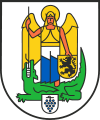 |
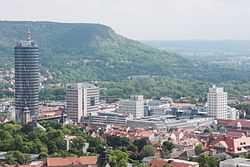 |
| 3 | Gera | independent | 95,384 | −0.55 |  |
.JPG) |
| 4 | Weimar | independent | 63,236 | +0.35 |  |
 |
| 5 | Gotha | Gotha | 44,371 | −0.05 |  |
 |
| 6 | Nordhausen | Nordhausen | 41,926 | −0.35 |  |
 |
| 7 | Eisenach | independent | 41,744 | −0.12 |  |
 |
| 8 | Suhl | independent | 35,967 | −1.68 |  |
 |
| 9 | Altenburg | Altenburger Land | 33,343 | −1.27 | 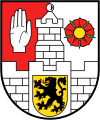 |
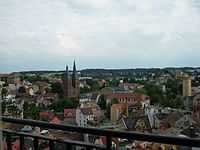 |
| 10 | Mühlhausen | Unstrut-Hainich-Kreis | 33,235 | −0.38 |  |
 |
* Average annual change in percent within the last three years (2009-12-31 until 2012-12-31), adjusted from incorporations and the 2011 Census results.
Religion
Since the Protestant Reformation, the largest religion in Thuringia has been Lutheranism. During the GDR period, church membership was discouraged and has continued shrinking since the reunification in 1990. Today over two thirds of the population is non-religious. As of 2009 the Evangelical Church in Germany remains the largest faith in the state, adhered to by 24.0% of the population. Members of the Catholic Church form 7.8%. 68.2% of the Thuringians are irreligious or adhere to other faiths.[5] The highest evangelical concentrations are in the small villages of southern and western Thuringia, whereas the bigger cities are even more atheistic (up to 88% in Gera). Catholic regions are the Eichsfeld in the northwest and parts of the Rhön Mountains around Geisa in the southwest. The Evangelical Church is shrinking rapidly, whereas the Catholic Church is somewhat more stable because of Catholic migration from Poland, Southern Europe and West Germany. Other religions play no role in Thuringia, there are only a few thousand Muslims (largely migrants) and about 750 Jews (mostly migrants from Russia) living in Thuringia. Furthermore, there are some Orthodox communities of Eastern European migrants and some traditional evangelical Free churches in Thuringia without any societal influence.
The evangelical parishes of Thuringia belong to the Evangelical Church in Central Germany or to the Evangelical Church of Hesse Electorate-Waldeck (Schmalkalden region). Catholic dioceses are Erfurt (most of Thuringia), Dresden-Meissen (eastern parts) and Fulda (Rhön around Geisa in the very west).
-
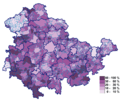
Evangelical membership in 2011 (municipalities)
-
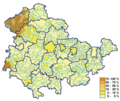
Catholic membership in 2011 (municipalities)
Politics
List of Minister-presidents of Thüringen
August 30, 2009 state election
| Party | Party list votes | Vote % (change) | Total Seats (change) | Seat % | |
|---|---|---|---|---|---|
| Christian Democratic Union (CDU) | 329,241 | 31.2% (−11.8) | 30 (−15) | 34.1% | |
| The Left | 288,932 | 27.4% (+1.3) | 27 (−1) | 30.7% | |
| Social Democratic Party (SPD) | 195,353 | 18.5% (+4) | 18 (+3) | 20.5% | |
| Free Democratic Party (FDP) | 80,511 | 7.6% (+4) | 7 (+7) | 8.0% | |
| Alliance '90/The Greens (Grüne) | 64,889 | 6.2% (+1.7) | 6 (+6) | 6.8% | |
| National Democratic Party (NPD) | 45,401 | 4.3% (+2.7) | – | – | |
| Free Voters in Thuringia | 40,834 | 3.9% (+1.3) | – | – | |
| All Others | 9,040 | 0.8% | – | – | |
| Totals | 1,054,201 | 100.0% | 88 | 100.0% | |
Turnout was 56.2%. SPD and CDU formed a coalition seven weeks after the election.[6]
Local government
Thuringia is divided into 17 districts (Landkreise):
|
|
.svg.png)
Furthermore there are six urban districts indicated by letter(s):
Economy
Thuringia's economy is marked by the economic transition that happened after the German reunification and led to the closure of most of the factories within the Land. The unemployment rate reached a peak around 2005. Since that year, the economy turns upward and the general economic situation improves.
Agriculture and forestry
Agriculture and forestry are from declining importance since decades, nevertheless, they are more important than in the most other German Lands, especially within rural regions. 54% of Thuringia's territory are in agricultural use. The fertile basins like the big Thuringian Basin or the smaller Goldene Aue, Orlasenke and Osterland are in intensive use for growing cereals, vegetables, fruits and energy crops. Important products are apples, strawberries, cherries and plums in fruit sector, cabbage, potatoes, cauliflower, tomatoes (in the greenhouse), onions, cucumbers and asparagus in vegetables sector as well as maize, rapeseed, wheat, barley and sugar beets in the crop sector.
Meat production and processing is also an important branch with pigs, cows, chickens and turkeys in focus. Furthermore, there are many milk and cheese producers, same as laying hens. Trouts and carps are traditionally breeded in aquaculture in many villages.
The most enterprises in agriculture are big cooperatives, founded as Landwirtschaftliche Produktionsgenossenschaft during the GDR period and the meat factories are part of multinational companies. Traditional private peasant agriculture is an exception, same as organic farming.
Thuringia's only wine-growing district is situated around Bad Sulza north of Weimar and Jena along the Ilm and Saale valley. It is marketed as Saale-Unstrut wines.
Forestry plays an important role in Thuringia, because 32% of the Thuringian territory is forested. The most grown trees are spruces, pines and beeches. There are many wood and paper factories next to the forested areas.
Industry and mining
Same as the most other regions in central and southern Germany Thuringia has a significant industrial sector until today, reaching back to the mid-19th century industrialisation. The economic transition after the German reunification in 1990 led to the closure of the most large-scale factories and companies, so that small and medium sized ones are dominating the economic structure. Well-known centres of the Thuringian industry are Jena (a world centre in optical production with companies like Carl Zeiss, Schott and Jenoptik) and Eisenach, where BMW started its car production in the 1920s and an Opel factory is based today. Most important industrial branches are engineering and metalworking, vehicle production and food industries. Especially the small and mid sized towns in central and southwestern Thuringia (e. g. Arnstadt, Schmalkalden and Ohrdruf) are marked by a distinct industrial structure, whereas there are less industrial companies within the northern and eastern parts of the Land. Traditional branches like production of glass, porcelaine and toys collapsed during the economic crisises between 1930 and 1990.
Mining was important in Thuringia since the later Middle Ages, specially within the Thuringian Forest and its mountain towns like Schmalkalden, Suhl and Ilmenau. With the industrialisation the old iron, copper and silver mines declined, because the competition of imported metal was to strong. On the other hand, the late 19th century brought new mines to Thuringia: The lignite surface mining around Meuselwitz next to Altenburg in the east of the Land started within the 1870s and two potash mining districts were established around 1900. The Südharzrevier in the north reaches from Bischofferode in the west to Roßleben in the east with Sondershausen as centre and the Werrarevier is situated in the west on the Hessian-Thuringian border around Vacha and Bad Salzungen. Both mined a significant amount of the world's potash production in mid-20th century. After the reunification, the Südharzrevier was abandoned, whereas K+S took over the mines in the Werrarevier. Between 1950 and 1990 uranium mining was also important to cover the Soviet Union's require for this metal. The centre was Ronneburg next to Gera in eastern Thuringia and the operating company Wismut was under direct Soviet rule.
General economic parameters
The GDP of Thuringia is below the national average, like in all the former East German Lands. Until 2004, Thuringia was one of the weakest regions within the European Union. The accession of several new countries, the crisis in southern Europe and the constant growth in Germany since 2005 led to the fact, that Thuringia is ranked within the EU average by now. The high economic subsidies granted by the federal government and the EU after 1990 are in gradual cutbacks and will end around 2020.
The unemployment rate reached its peak in 2005 with an amount of 20%. Since that time, it decreases down to 7% in 2013, which is only a little bit more than the national average. The decrease is caused on the one hand by the emergence of new jobs and on the other hand by the strong shrinkage of population in working age, caused by various demographic effects. The wages in Thuringia are low, compared to rich bordering Lands like Hesse and Bavaria. Therefore, many Thuringians are working in other German Lands and even in Austria and Switzerland as weekly commuters. Nevertheless, the demographic transition in Thuringia leads to a lack of workers in some branches, which is a growing problem. To handle that, external migration to Thuringia is forced by the government since about 2010.
The economic progress is quite different between the regions of Thuringia. The big cities along the Bundesautobahn 4 like Erfurt, Jena and Eisenach and their surroundings are booming, whereas nearly all the rural regions, especially in the north and east are without any economic impetus and employment, which is a big issue in regional planning. The remaining young people there often have to commute to long distances, but many emigrate immediately after they finished school.
Infrastructure
Transport
As Germany's most central Land, Thuringia is an important hub of transit traffic. The transportation infrastructure was in very bad condition after the GDR period. Since 1990, many billions of Euros have been invested to improve the condition of streets and railways within Thuringia.
During the 1930s, the first two Autobahns were built across the Land: The Bundesautobahn 4 as an important east-west connection in central Germany and the main link between Berlin and south-west Germany and the Bundesautobahn 9 as the main north-south route in eastern Germany, connecting Berlin with Munich. The A 4 from Frankfurt runs via Eisenach, Gotha, Erfurt, Weimar, Jena and Gera to Dresden across Thuringia and links the Land's most important cities. At Hermsdorf junction it is connected with the A 9. Both highways were broaden from 4 to 6 lines (3 per direction) after 1990, including expensive shifts in the Eisenach and the Jena region. Furthermore, three new Autobahns were built during the 1990s and 2000s. The Bundesautobahn 71 crosses the Land in southwest-northeast direction, connecting Würzburg via Meiningen, Suhl, Ilmenau, Arnstadt, Erfurt and Sömmerda with Sangerhausen/Halle. The crossing of the Thuringian Forest within the A 71 has been one of Germany's most expensive Autobahn segments with various tunnels (including Germany's longest road tunnel, the Rennsteig Tunnel) and large bridges. The Bundesautobahn 73 starts at the A 71 south of Erfurt in Suhl and runs southwards to Nuremberg. The Bundesautobahn 38 is another west-east connection in the north of Thuringia running from Göttingen via Heiligenstadt and Nordhausen to Leipzig. Furthermore, there is a tight network of Bundesstraßen complementing the Autobahn network and connecting regions without Autobahns. The upgrading of Bundesstraßen is an emphasis within the Bundesverkehrswegeplan 2015 (federal street building programme 2015), with many projects along the Bundesstraße 247 from Gotha to Leinefelde to better Mühlhausen's connection, the Bundesstraße 19 from Eisenach to Meiningen for improving Bad Salzungen's and Schmalkalden's connection same as along Bundesstraße 88 and Bundesstraße 281 for strengthening the Saalfeld/Rudolstadt region.
The first railways in Thuringia had been built in the 1840s and the network of main lines was finished around 1880. Until 1920, many secondary railways were built, so that Thuringia had one of the tightest rail networks in the world before World War II with about 2,500 kilometres. Between 1950 and 2000, most of the secondary railways got abandoned, so that Thuringia's network today is only half as long as in 1940. On the other hand, most of the main lines got refurbished after 1990 to grant relatively high travel velocity. The most important railways are the Thuringian Railway, connecting Halle and Leipzig via Weimar, Erfurt, Gotha and Eisenach with Frankfurt and Kassel and the Saal Railway from Halle/Leipzig via Jena and Saalfeld to Nuremberg. On the first line is an hourly ICE/IC service from Dresden to Frankfurt and on the second also an hourly ICE service from Berlin to Munich. In 2017, a new high speed line will be opened in Thuringia, taking over the long-distance trains from the mid-19th century lines. The Erfurt–Leipzig/Halle high-speed railway will be used by both ICE lines and the Nuremberg–Erfurt high-speed railway will be used by the Berlin-Munich line. Only the segment west of Erfurt of the Frankfurt-Dresden line will stay in use for ICE trains after 2017, but an increase of velocity to 200 km/h is planned here (now: 160 km/h). Erfurt Hauptbahnhof will be the new connection between both ICE lines, for that reason, the station was completely rebuilt during the 2000s. The most important regional railways in Thuringia are the Neudietendorf–Ritschenhausen railway from Erfurt to Würzburg, the Weimar–Gera railway from Erfurt to Chemnitz, the Sangerhausen–Erfurt railway from Erfurt to Magdeburg, the Gotha–Leinefelde railway from Erfurt to Göttingen, the Halle–Kassel railway from Halle via Nordhausen to Kassel and the Leipzig–Hof railway from Leipzig via Altenburg to Zwickau and Hof. The most regional and local trains offer hourly service, but some run only every two hours.
There are some small airports in Thuringia. The only one with public aviation is the Erfurt–Weimar Airport next to Erfurt. It is in use for holiday flights to the Mediterranean and other turistic regions. Regular flights are carried out via the major airports around like Frankfurt Airport, Berlin Brandenburg Airport and Munich Airport. The Leipzig–Altenburg Airport next to Altenburg was in use between 2003 and 2011 for Ryanair flights.
Thuringia is Germany's only Land without connection to waterways, because all the rivers are to small for navigating them.
Energy and water supply
The traditional energy supply of Thuringia is lignite, mined in the bordering Leipzig region. Since 2000, the importance of environmentally unfriendly lignite combustion declines in favour of renewable energies, which reached an amount of 40% (in 2013), and more clean gas combustion, often carried out as Cogeneration in the municipal power stations. The most important forms of renewable energies are Wind power and Biomass, followed by Solar energy and Hydroelectricity. Furthermore, Thuringia hosts two big pumped storage stations: the Goldisthal Pumped Storage Station and the Hohenwarte Dam.
The water supply is granted by the big dams, like the Leibis-Lichte Dam, within the Thuringian Forest and the Thuringian Highland, making a drinking water exporter of Thuringia.
Health
In general, the health and the health supply in Thuringia improved after 1990. The life expectancy rose, nevertheless it is still a bit smaller than the German average. This is caused by a relatively unhealthful lifestyle of the Thuringians, especially in high consumption of meat, fat and alcohol, which led to significant higher rates of overweight compared to the German average.
The health supply in Thuringia undergoes a concentration process in the moment. Many smaller hospitals in the rural towns close, whereas the bigger ones in centres like Jena and Erfurt get enlarged. Overall, there is an oversupply with hospital beds, caused by rationalisation processes in the German health supply system, so that many smaller hospitals generate losses. On the other hand, there is a lack of family doctors, especially in rural regions with increased need of medical supply because of overageing.
Education
In Germany, the educational system is part of the sovereignty of the Lands, so that each land has its own school and college system.
School system
See also: Education in Germany
The Thuringian school system was developed after the reunification in 1990 with a mixture of some elements of the former GDR school system and the Bavarian school system. Most inner-German rankings attest that Thuringia has one of the most successful education systems in Germany, granting high-quality results.
Early child education is quite common in Thuringia. Since the 1950s, nearly all the children use the supply, whereas in western Germany, the early child education supply is still bad. Its inventor Friedrich Fröbel lived in Thuringia and founded the world's first Kindergartens here in 19th century. The Thuringian elementary school takes 4 years and most elementary schools are all-day schools offering an optional afternoon care. At the age of 10, the children are spread to different types of schools: the Gymnasium, where they can pass the Abitur exam after 8 years, and the Regelschule, a combination of Realschule and Hauptschule, where they can pass two different exams after 5 or 6 years.
Universities
The German college education system knows two forms of academic institutions: the university and the Fachhochschule. Thuringia hosts four universities. The biggest one offering nearly every discipline is the University of Jena, founded in 1558, with 21,000 students. The second-largest is the Technische Universität Ilmenau with 7,000 students, founded in 1894, which offers many technical disciplines like engineering and mathematics. The University of Erfurt, founded in 1392, has 5,000 students today and an emphasis on humanities and teachers education. The Bauhaus University Weimar with 4,000 students is Thuringia's smallest university with creative disciplines like architecture and arts in focus. It was founded in 1860 and has also a great tradition as Germany's leading art school during the interwar period, the Bauhaus.
The Fachhochschulen in Thuringia are based in Erfurt (4,500 students), Jena (5,000 students), Nordhausen (2,500 students) and Schmalkalden (3,000 students). Furthermore, the governmental college in Gotha has the state of a Fachhochschule and 500 students, same as the Hochschule für Musik "Franz Liszt", Weimar (800 students). There are two private colleges in Thuringia: the Adam-Ries-Fachhochschule in Erfurt (500 students) and the SRH Fachhochschule für Gesundheit Gera in Gera (500 students). Another type of Fachhochschule are the Berufsakademies in Eisenach (600 students) and Gera (700 students).
Research
Thuringia's leading research centre is Jena, followed up by Ilmenau. Both have high-tech innovations in focus, first with an emphasis on life sciences and optics and second on information technology. Erfurt is a centre of Germany's horticultural research, whereas Weimar and Gotha with their various archives and old libraries are centres of historic and cultural research. Nevertheless, most of the research in Thuringia is public financed basic research, because there are no big companies in the Land having enough ressources for product research (except from a few companies in Jena).
References
- ↑ "Bevölkerung der Gemeinden, erfüllenden Gemeinden und Verwaltungsgemeinschaften nach Geschlecht in Thüringen". Thüringer Landesamt für Statistik (in German). 13 July 2013.
- ↑ A. Trinius (1898)
- ↑ http://www.leg-thueringen.de/index.php?id=1982&L=1
- ↑ "World Weather Information Service - Erfurt". World Meteorological Organization. Retrieved 22 January 2013.
- ↑ Statistisches Jahrbuch Thüringen 2011 - PDF, 4,3 MB
- ↑ CDU and SPD form Thuringia state coalition, The Local; 19 October 2009.
External links
| Wikimedia Commons has media related to Thuringia. |
- Official government site
- Tourist website for Thuringia (German)
- Official Directory (German)
- Another Tourist website for Thuringia
- Historical Overview
- Tourist website with many pictures of thuringian landscapes (German)
- Alternative Tourist website for Thuringia (German) (English)
- Thuringia on the Open Directory Project
- Thuringian flags at
- "Thuringia (Germany)". Fotw.vexillum.com. Retrieved 2010-05-22.
- Marcus Schmöger. "Thüringen". Flaggenkunde.de. Retrieved 2010-05-22.
- Search engine for Thuringia with videos (German)
-
 Geographic data related to Thuringia at OpenStreetMap
Geographic data related to Thuringia at OpenStreetMap
| |||||||||||||
| ||||||||
| ||||||||||||||||||||||||



